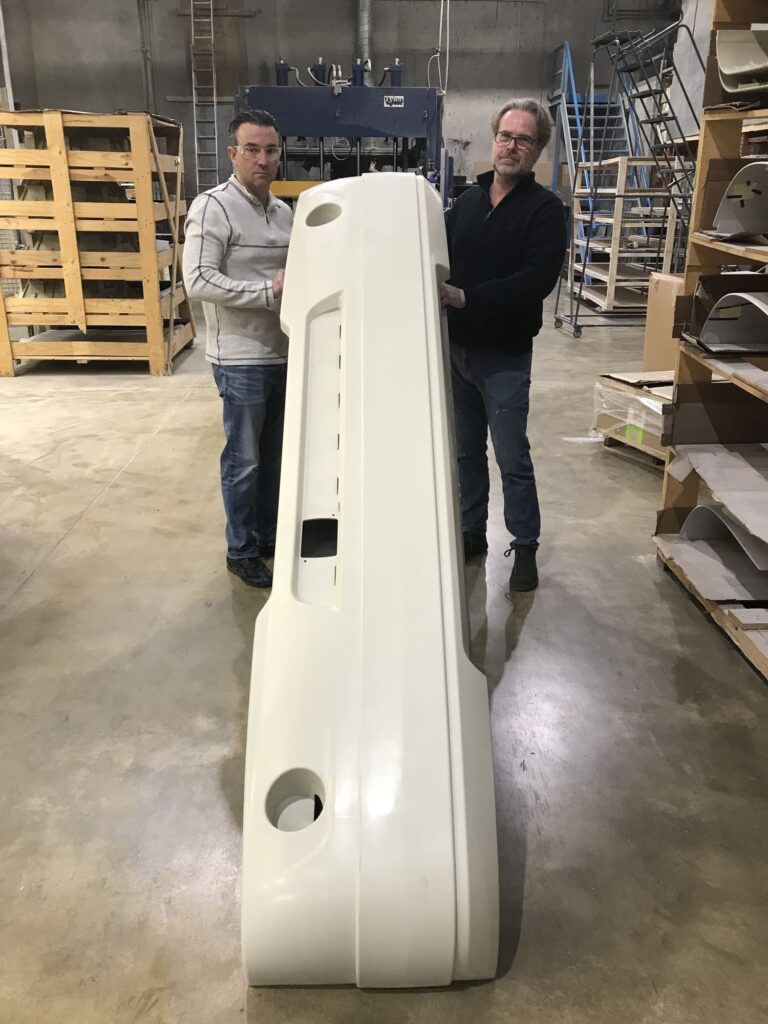Reaction Injection Molding (RIM) for Bumpers

Reaction injection molding (RIM) is a very cost-efficient and effective method to create parts for vehicles, such as bumpers for cars, buses, and other types of vehicles. The RIM process can make your vehicle’s bumper strong and impact-resistant, but also lightweight.
Vehicle bumpers that are formed with reaction injection molding use an exothermic chemical reaction to produce a strong, pact-resistant, and flexible material substrate. This also gives you options for designing the bumper with large complex geometries, deep draws, and cylindrical features of size. In many ways, you can customize your molds to your design standards.
Unlike traditional molding, RIM molding uses lightweight, cost-efficient thermoset polymers.
The Reaction Injection Molding Process for Bumpers
The RIM process begins with two liquids: isocyanate and polyol. These two materials are fed from individual storage tanks to temperature-controlled day tanks where they are continually recirculated until a shot is called for at the tool mix head. The mix head allows the material to flow into the tool. A piston retracts in the head allowing the two liquids to mix and they flow into the tool with little pressure.
The chemical liquids have to be mixed at a high velocity of at least 1200psi. You must make sure you are using an impinging mixer before moving it into the mold. The liquid polymers will require less pressure as the curing process occurs. The liquids need to be in a low-pressure area, at least around 100psi for the curing process to work. It also will need to have at least a heat level of 180 degrees Fahrenheit (82 degrees Celsius). These are the minimum requirements for the curing of the mold. The time for the mixture to cure is somewhere between 1 minute and several minutes depending on the size and complexity of the tool designed to make a motor home bumper as an example. Depending on the material selection, many of these parameters can be changed to affect fill, cure time, shot time and overall part quality and cycle time.
Advantages of Reaction Injection Molding for Bumpers

There are also so many advantages to molding bumpers with RIM and RIM materials. These materials are strong, appeal to large part manufacturing and lightweight making them perfect for a motor home application. They are very tough as they can take a hit and still retain their original design state/shape. They are very impact resistant making them a very strong and longer-lasting product. RIM molding works really well as bumpers because they have many customizable options. The tooling can incorporate such design details such as inserts to make different versions of a bumper with one tool and various inserts for such things as cut outs or changes in length.
Bumpers made out of these polymers are also much more fuel-efficient due to the weight reduction of the vehicle. The polymer and process are very flexible in terms of design freedom. In addition, RIM is non-corrosive and chemically resistant. This makes RIM perfect for a bumper application where they are continually exposed to chemicals in garages and use environments.
Get Started with Custom Reaction Injection Molding for Car, Motorhome, & Vehicle Bumpers
Thieme specializes in custom reaction injection molding solutions for a wide range of vehicle parts. With our advanced RIM technology, comprehensive process knowledge, and responsive service, we are proud to be a reliable and trusted suppliers for bumper and vehicle part molding solutions.
Are you ready to get started with custom reaction injection molding for car bumpers, motorhome bumpers, or any other vehicle?
At Thieme, our full-service team will work with you through every phase of your upcoming RIM project, from conceptualization and planning to production and fulfillment. Reach out to us today to request a consultation and learn more about the reaction injection molding process for bumpers.



